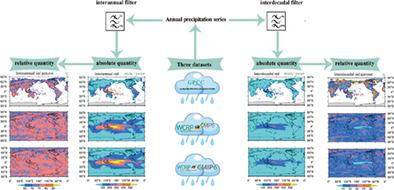当前位置:
X-MOL 学术
›
Int. J. Climatol.
›
论文详情
Our official English website, www.x-mol.net, welcomes your
feedback! (Note: you will need to create a separate account there.)
Interdecadal and interannual evolution characteristics of the global surface precipitation anomaly shown by CMIP5 and CMIP6 models
International Journal of Climatology ( IF 3.5 ) Pub Date : 2020-07-19 , DOI: 10.1002/joc.6756 Yuyao Zhu 1, 2, 3 , Saini Yang 1, 2, 3
International Journal of Climatology ( IF 3.5 ) Pub Date : 2020-07-19 , DOI: 10.1002/joc.6756 Yuyao Zhu 1, 2, 3 , Saini Yang 1, 2, 3
Affiliation

|
Coupled Model Intercomparison Project Phase 5 (CMIP5) models have limited capacity for depicting the variability of precipitation at interannual and interdecadal timescales. This study analyses the relative magnitude of interannual to multidecadal variability in annual precipitation across the world in the recently released CMIP6 dataset by quantifying the discrepancy between observed and modelled CMIP5 and CMIP6 data, considering both the absolute and relative magnitude of precipitation variability. We found that: (a) similar to CMIP5, CMIP6 models were short of capacity to simulate the non‐homogeneity in the relative magnitude of interdecadal variability, which is linked to prolonged drought and pluvials in terms of the strength value. The relative value of the interdecadal variability ranged from 15% to more than 30% in observation. Compared with observational data, the relative magnitude, having spatial uniformity, mostly ranged from 10 to 20% in CMIP5 and CMIP6. This result suggests that future projections lack a sufficient decadal variability in CMIP6, indicating a limited capacity for the prediction of floods and droughts in regions like central Africa, North America, and Amazonia; (b) Most individual models in CMIP6 had a better performance in terms of the spatial distribution of the interdecadal precipitation as compared to CMIP5. However, the absolute variations of the overall, interannual, and interdecadal precipitation of multi‐model ensemble simulations (MME) in CMIP6 were larger than those in CMIP5; (c) the underestimation of the interdecadal component in different areas was markedly decreased in East Asia, South Asia but increased in North and South Africa in CMIP6, when compared with CMIP5 and (d) For future scenarios, the higher the range of future forcing pathway is, the larger interdecadal and interannual variabilities are in all regions in CMIP6. For future persistent droughts and floods predicting in a specific region, it is necessary to consider the discrepancy between historical simulations and observational data, and select the performance‐plus models.
中文翻译:

CMIP5和CMIP6模型显示的全球地表降水异常的年代际和年际演化特征
耦合模型比较项目第5阶段(CMIP5)模型在描述年际和年代际时间尺度上降水变化的能力有限。这项研究通过对观测和建模的CMIP5和CMIP6数据之间的差异进行量化,同时考虑了降水变异性的绝对值和相对值,分析了最近发布的CMIP6数据集中全球年降水量的年际至年代际变化的相对幅度。我们发现:(a)与CMIP5类似,CMIP6模型缺乏模拟年代际变异性相对幅度中的非均质性的能力,这在强度值方面与长期干旱和小雨有关。在观测中,年代际变化的相对值范围从15%到大于30%。与观测数据相比,在CMIP5和CMIP6中,具有空间均匀性的相对幅度通常在10%到20%之间。该结果表明,未来的预测在CMIP6中缺乏足够的年代际变化,这表明中非,北美和亚马逊地区等地区的洪水和干旱预测能力有限;(b)与CMIP5相比,CMIP6中的大多数单个模型在年代际降水的空间分布方面具有更好的性能。但是,CMIP6中多模型合奏模拟(MME)的总体,年际和年代际降水的绝对变化大于CMIP5。(c)东亚不同地区年代际分量的低估明显减少,与CMIP5相比,南亚在CMIP6中有所增加,但在北非和南非有所增加。(d)对于未来情况,未来强迫途径的范围越大,CMIP6中所有区域的年代际和年际变化都越大。对于特定区域未来的持续干旱和洪水预报,有必要考虑历史模拟与观测数据之间的差异,并选择性能加模型。
更新日期:2020-07-19
中文翻译:

CMIP5和CMIP6模型显示的全球地表降水异常的年代际和年际演化特征
耦合模型比较项目第5阶段(CMIP5)模型在描述年际和年代际时间尺度上降水变化的能力有限。这项研究通过对观测和建模的CMIP5和CMIP6数据之间的差异进行量化,同时考虑了降水变异性的绝对值和相对值,分析了最近发布的CMIP6数据集中全球年降水量的年际至年代际变化的相对幅度。我们发现:(a)与CMIP5类似,CMIP6模型缺乏模拟年代际变异性相对幅度中的非均质性的能力,这在强度值方面与长期干旱和小雨有关。在观测中,年代际变化的相对值范围从15%到大于30%。与观测数据相比,在CMIP5和CMIP6中,具有空间均匀性的相对幅度通常在10%到20%之间。该结果表明,未来的预测在CMIP6中缺乏足够的年代际变化,这表明中非,北美和亚马逊地区等地区的洪水和干旱预测能力有限;(b)与CMIP5相比,CMIP6中的大多数单个模型在年代际降水的空间分布方面具有更好的性能。但是,CMIP6中多模型合奏模拟(MME)的总体,年际和年代际降水的绝对变化大于CMIP5。(c)东亚不同地区年代际分量的低估明显减少,与CMIP5相比,南亚在CMIP6中有所增加,但在北非和南非有所增加。(d)对于未来情况,未来强迫途径的范围越大,CMIP6中所有区域的年代际和年际变化都越大。对于特定区域未来的持续干旱和洪水预报,有必要考虑历史模拟与观测数据之间的差异,并选择性能加模型。











































 京公网安备 11010802027423号
京公网安备 11010802027423号